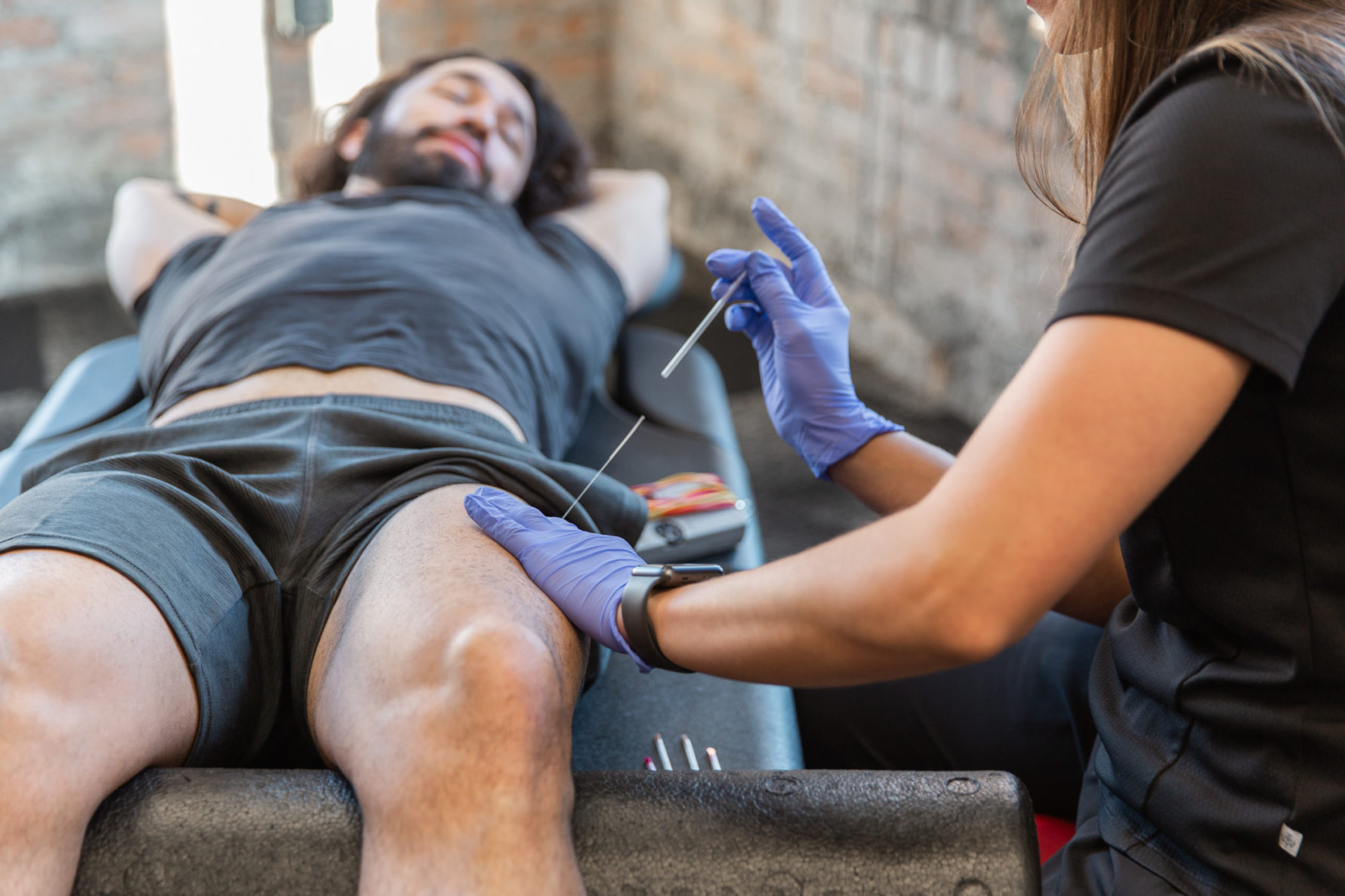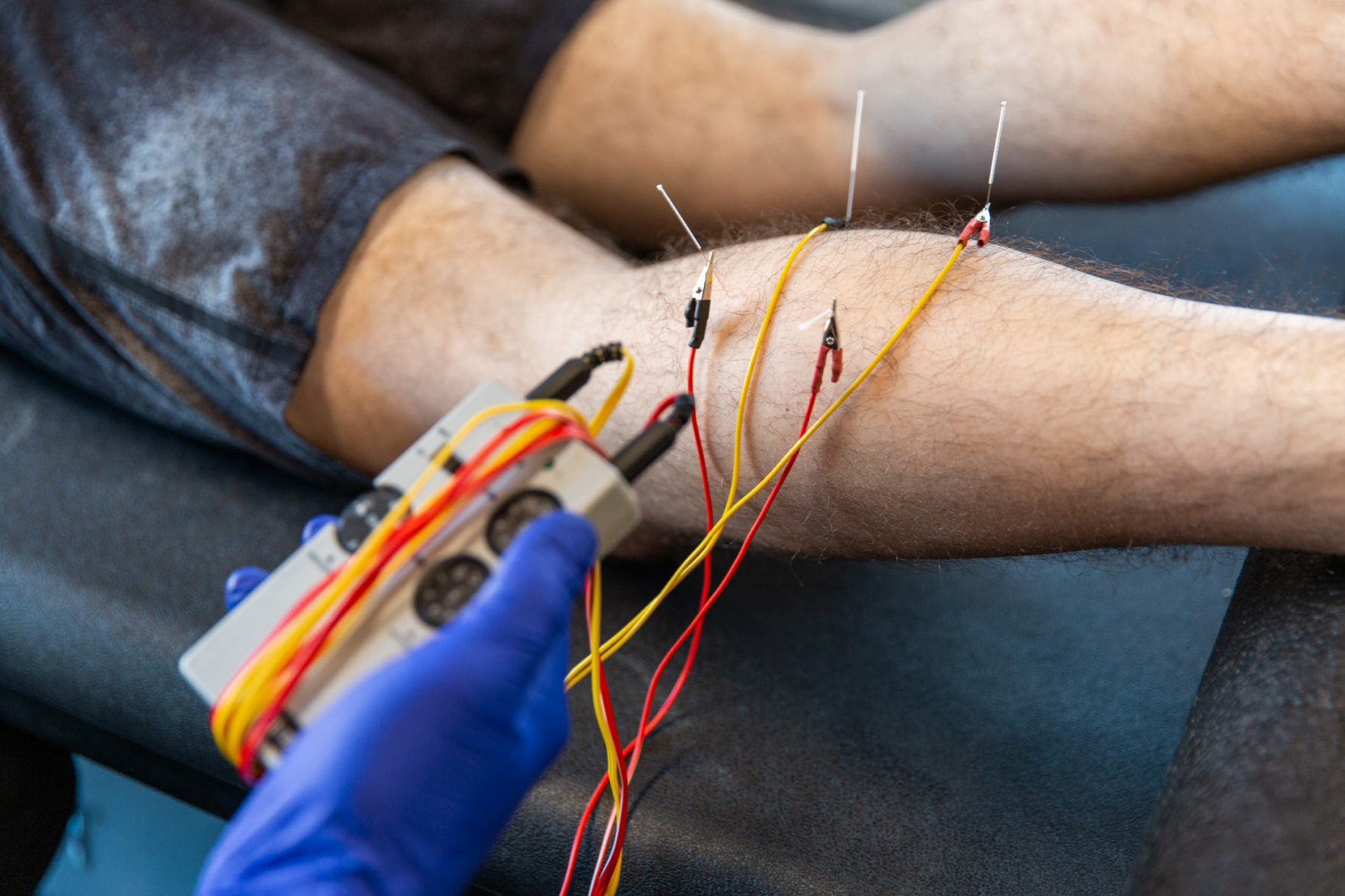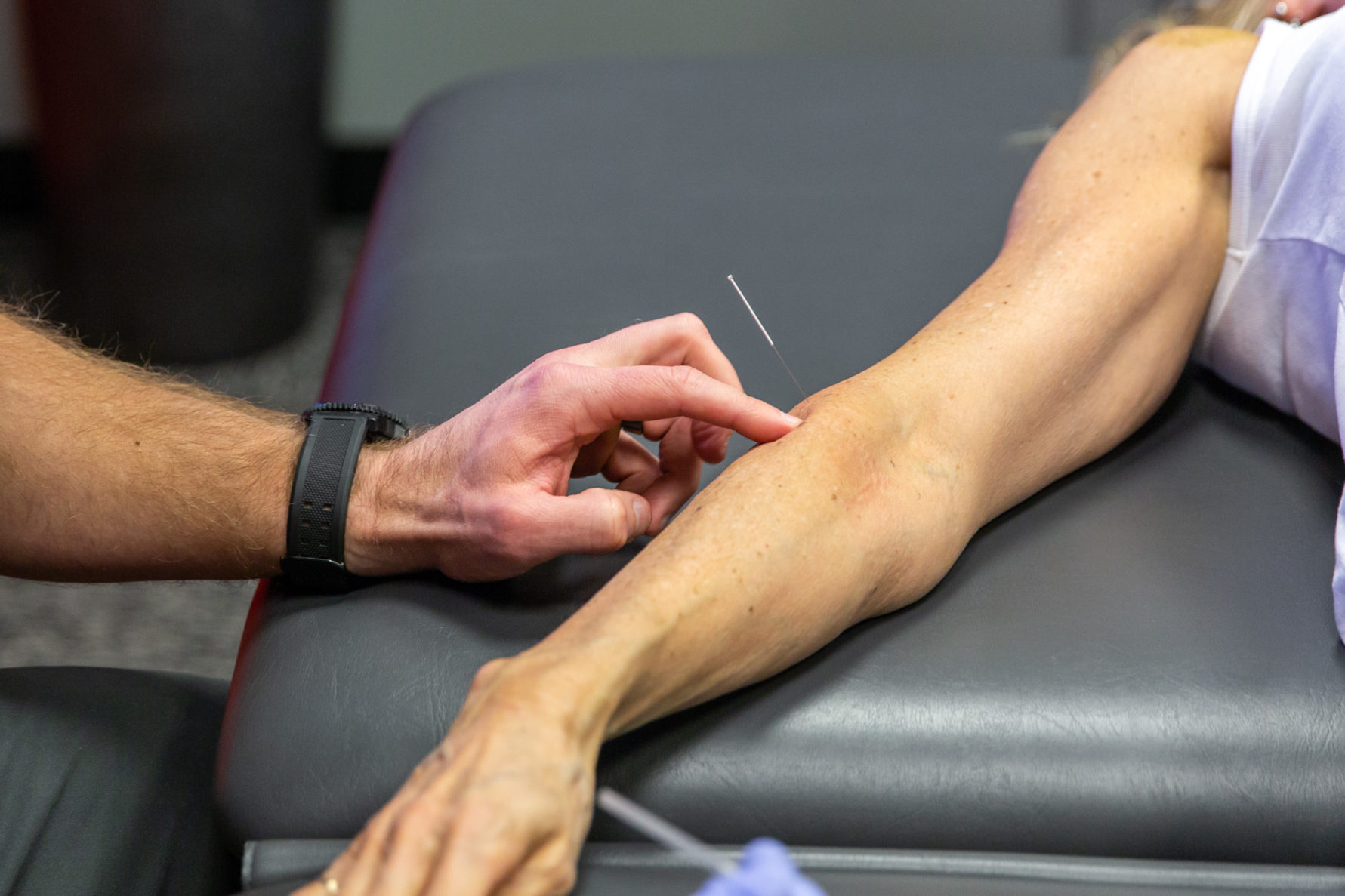
Dry Needling is the process of using a thin needle inserted into a trigger point to relieve a contraction within a muscle.
Chiropractic Dry Needling in Kansas City
Chiropractic Dry Needling
Chiropractic Dry Needling is a manual, therapeutic technique aimed at healing dysfunctional muscle tissue in the body. Using a thin needle, such as those used in acupuncture, our chiropractors can pierce the skin and target a myofascial trigger point (taut band of tissue). This provokes an involuntary twitch response and a variety of biochemical reactions, which reduces tension in the muscle and helps restore normal function. If you’re having trouble with muscle pain or function, dry needling in Kansas City may be able to help!
What It Treats
Chiropractic Dry Needling in Kansas City can help reduce or even eliminate musculoskeletal dysfunction and pain associated with, but not limited to:
- Headaches
- Back pain
- Neck pain
- Plantar fasciitis
- Achilles tendinitis
- Jaw pain
- Shoulder pain
- Carpal tunnel syndrome
- Sciatica
- Knee pain
- Tennis elbow
- Shin splints
- Little leaguers elbow
- Nerve entrapments


How Dry Needling Works
When targeted at an active trigger point, dry needling can prompt a variety of physiological processes. The body’s classic response to dry needling is called a local twitch response (LTR). An LTR is an involuntary reflex or twitch within the tight and adhered tissue.
The Dry Needling process works by interrupting the improper communication at the motor-end plates of your muscle(s). This allows the muscles and the brain to essentially “relearn” how to communicate. Once we re-establish this communication, your joint can return to its proper position and motion to alleviate pain.
During a Dry Needling session filiform needles, fine (0.3mm diameter), short needles without a hollow center for injecting fluid, are inserted into tight or dysfunctional tissue. By inserting the needles into myofascial trigger points, the treatment promotes intramuscular stimulation to increase blood flow in the area and muscular “knots.” This assists in releasing the trigger point and muscular tension which results in decreased pain, and lowers acid levels. Electrical stimulation is frequently paired with Dry Needling to further relax the muscle and regulate neuromuscular activity. As a result, patients can enjoy relief and an increased range of motion.
Our trained chiropractor and physical therapists at F.I.T. Muscle & Joint Clinic have extensive education in Dry Needling, allowing us to cater each treatment to each individual patient. That means patients never receive a generalized treatment. As a result, we can successfully treat conditions such as headaches, back pain, plantar fasciitis, knee pain, nerve entrapments, and more with Dry Needling in conjunction with other manual therapy techniques and corrective exercises.

Additional Benefits
In addition, Chiropractic Dry Needling in Kansas City improves circulation to the site of trauma, allowing us to restore normal blood flow and oxygen to the area. It also raises the pH level of the area to that of a normal value, thereby reducing local inflammation and promoting healing.
When it comes to modulating pain, Dry Needling can decrease nociceptive input (pain) and biochemical agents along with activation of higher centers of the brain. This is a direct result of the mechanical stimulation from the needle.
What are myofascial trigger points?
The term “myo” describes the muscle, and “fascial” describes the connective tissue that stabilizes, encloses, and separates muscles and other internal organs. Trigger points are simply a knot made from groups of muscles that shorten when activated but don’t lengthen to relax. Without lengthening, the muscles stay in a “balled up” state, which causes stiffness, pain, and excess tension.
These trigger points develop sensitive nodules in the muscle, and the muscle becomes so tight it compresses the capillaries and nerves that supply it. Without proper supply, the muscle can’t move properly, gain fresh oxygen and nutrients, or eliminate excess acidic chemicals.
Trigger points come from both injury from activity/sports or lack of activity often in combination with poor posture/improper body mechanics. When patients have a myofascial trigger point, they may notice discomfort when touching the area, pain when stretching and moving or at rest, decreased joint movement and possible temporary loss in coordination or strength of muscular contraction.

How F.I.T. Uses Dry Needling
F.I.T. Muscle & Joint Clinic utilizes Dry Needling for a variety of conditions. With any injury to the body, there is inflammation and a cascade of events that can lead to taut bands of muscles and trigger points. Once these trigger points are formed, the entire muscle and chain of muscles become dysfunctional.
The chiropractors at F.I.T. use Dry Needling to restore proper muscle length. We supplement all Dry Needling in Kansas City with rehab exercises to retrain the injured area and re-establish full function.
Our team focuses on providing the best care to maximize patient outcomes. Because of this, we study and understand how to use filiform needles to individualize each treatment to a patient’s needs. This allows us to hone in on specific structures to target the underlying soft tissue and trigger points.
F.I.T. uses Dry Needling as a minimally-invasive therapy to improve blood flow and break up scarred or adhered soft tissue. Our chiropractors and physical therapists use the technique on a variety of patients, no matter how small or big the problem. Since our therapy is so customized, each patient receives a treatment that is exclusively their own, rather than a one-size-fits-all treatment.
Our clinicians have performed countless Dry Needling treatments and continue to attend continuing education courses and training specifically for musculoskeletal patient care in order to provide the most optimal and up to date care possible. We don’t believe in generalized treatments simply because we don’t deal with generalized problems. At F.I.T. Muscle & Joint Clinic, we support our patients through their journey from start to finish.
How do soft tissue adhesions form?
Soft tissue adhesions play a major role in the formation of trigger points, and they can develop in different ways depending on the patient’s lifestyle. Typically, our team sees patients with these fibrous bands after injuries, surgery, improper movement, and even poor posture. Although part of the body’s natural healing process, they may cause stiffness and pain in some people.
Oftentimes, muscle overuse without the right amount of recovery could also lead to adhesions and scarring. Muscle overuse and the resulting adhesions may come from an accumulation of microtraumas (small tears), not getting enough oxygen, and abrupt acute factors (collisions, injuries, pulls, tears, etc.).
Scar tissue and adhesions depend on collagen to rebuild. Collagen is a structural protein found throughout the body, including your skin, bones, muscles, tendons, ligaments, and other soft tissue. Due to its cellular alignment, collagen is extremely strong, enabling it to resist forces like stretching and pulling without breaking.
After an injury, the healing process cleans the site and pulls in new cells, some of which are collagen cells. Scar tissue forms because the body doesn’t know exactly how to rearrange those collage cells so they form healthy tissue. As a result, the cells can begin to clump together leading to discomfort, pain, and flexibility restrictions.
Regardless of how a patient’s soft tissue adhesions came about, the providers at F.I.T. Muscle & Joint Clinic can utilize Dry Needling to treat the variety of different ailments they cause. Our goal is to focus on each patient’s goals to ensure we perform the treatment up to standard. A Dry Needling session should never implement the same techniques for every patient, so patients should expect their clinician to adjust his or her treatment at each session to reach the optimal patient outcome.
We recommend that patients always speak to our team or visit one of our offices to determine if Dry Needling is right for them.
Frequently Asked Questions
Is Dry Needling the same as acupuncture?
Although both utilize similar size needles, Dry Needling and Acupuncture are different techniques that serve different purposes in the healing process.
Is Dry Needling safe?
The chiropractors at F.I.T. Muscle & Joint Clinic value your safety and well-being and would not offer a procedure unless it was in your best interest. However, there are risks associated with Dry Needling in Kansas City, just as there are with any medical procedure. Feel free to give us a call and one of our providers will be happy to discuss the risks and benefits of Dry Needling with you.
Does Dry Needling hurt?
The majority of our KC patients do not describe Dry Needling as painful. Rather, they report it feels uncomfortable—not from the needle itself, but from the muscular contraction associated with the necessary twitch response.
Is Dry Needling right for you?
Take a couple of minutes to tell us about your symptoms and pain areas. Prefer to chat over the phone? Call us for a free phone consultation.
Visit your local F.I.T.
Meet the team at any of our 10 locations: Lee’s Summit, Liberty, Leawood, Crossroads, Paola, Blue Valley, Kansas City, Olathe, Overland Park & Shawnee.


